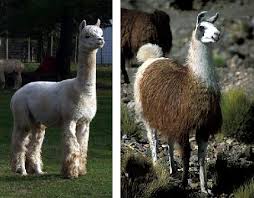It is bound to come up in any social setting. The unanswered question, what is it, an alpaca or llama? And if you are having difficulty answering this question, then you should be at the 21st Virginia Classic Llama and Alpaca Show, to be held in Lexington, Virginia, at the Virginia Horse Center on March 7-8.

Or you could just read the rest of this blog post!
Either way, you will be the life of the party when the question comes up. Is it an alpaca or llama? Now you will know!
Enjoy. And don’t miss the Virginia Classic on March 7-8.
Scientifically, alpacas and llamas are very closely related. They look similar, but put them side by side and you’ll see that the alpaca is much, much smaller than the llama. Llamas have long been used for pack animals, valued for their strength and endurance. Alpacas are raised almost solely for their finer wool, called fleece, and were exported from their native South America almost a century after their llama cousins.
One of the most obvious differences between the two species is their wool or (more accurately) their fiber. Both the llama and the alpaca have been raised for their fiber, which is shorn once a year in both cases. The alpaca is much more prized for their fiber, and for many farmers, that’s the only reason they are raised.
There are two types of alpacas, each defined by their fiber; both types are soft and hypoallergenic. The Huacaya has a sheep-like appearance, with short, soft fiber. The Suri has a longer coat, with a fleece that gathers like ropes and hangs from the body. The fleece of both types of alpaca is very, very soft, and is usually used to make clothing. There are 22 different “recognized” colors for an alpaca, ranging from black to white and including every shade of brown, cream, and gray in between. Alpacas are typically one color, with white markings only on the face and legs, making their fleece uniform in color.
The llama, on the other hand, has two layers to their fleece. The inner coat is soft; on the animal, it keeps them warm while their outer coat, made of stiffer guard hairs, keeps them dry. The undercoat is soft enough to use for clothing, while the outer coat is more often used to make more utilitarian items like rugs and ropes. Before anything can be done with the fiber, the two coats have to be separated. Llamas come in fewer colors than alpacas, and can be spotted.
Llamas are much larger than alpacas, and because of their size they can also be used as pack animals. An adult llama usually stands around 1.8 meters (6 ft) tall and weighs anywhere between 125 and 200 kilogram (280 and 450 lbs), while an average alpaca only stands about 0.9 meters (3 ft) tall at the shoulder and weighs between 45 and 80 kilograms (100 and 175 lbs).
While alpacas are mainly kept for their fleece, llamas can serve a few different purposes on a farm. When kept with other animals such as sheep, llamas can serve as guard animals against predators and intruders, although not all llamas have the personality for guard duty. Both are easy to train, and because of their size and strength, llamas can be taught to pull carts and small carriages. Llamas can also be trained to accept a rider, although that rider needs to be fairly lightweight.
In South America—where both animals are much more common—they can also be used as meat and dairy animals.
Alpacas and llamas actually have two more closely related cousins. The guanaco and the vicuna are two other species ofcamelidae that have not been domesticated. Both still roam the hills and mountains of South America, specifically through Peru and Chile. Unfortunately, the guanaco population is rapidly declining because of human encroachment on their territory, poaching, and herd fragmentation. The vicuna have long lived alongside humans; they were invaluable to the Inca, who once captured wild animals, sheared them for their wool, and released them back into the wild.
This information originally appeared in KnowledgeNuts, December 2013, by Debra Kelly
